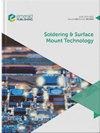细节距铜桩凸点WLP热-机械可靠性分析
IF 1.8
4区 材料科学
Q3 ENGINEERING, ELECTRICAL & ELECTRONIC
引用次数: 3
摘要
目的研究晶圆级封装(WLP)中的几个参数,找出影响热疲劳寿命的最关键因素,如铜柱高度、凸点高度和芯片厚度。有限元分析结果表明,凸点高度是整个结构中最重要的影响因素。设计/方法/方法提出了65µm间距的铜柱凸点来研究WLP的热机械性能。采用热循环模拟的方法,利用有限元分析方法,对WLP的可靠性进行了评价。采用田口法求出三维有限元模型参数的灵敏度,得到优化构型。结果表明,优化后的热疲劳寿命比原设计提高了147%。独创性/价值:有限元模拟结果表明,所提出的65µm节距的WLP铜柱凸点具有良好的热力学性能,具有低塑性应变和高热疲劳寿命,符合移动设备的要求。本文章由计算机程序翻译,如有差异,请以英文原文为准。
Thermal-mechanical reliability analysis of WLP with fine-pitch copper post bumps
Purpose
This study aims to investigate the several parameters in wafer-level packaging (WLP) to find the most critical factor impacting the thermal fatigue life, such as the height of copper post, the height of solder bump, the thickness of chip. The FEA results indicate the height of solder bumps is the most important factor in the whole structure.
Design/methodology/approach
The copper post bumps with 65 µm pitch are proposed to investigate the thermal-mechanical performance of WLP. The thermal cycle simulation is used to evaluate the reliability of WLP by using finite element analysis (FEA). Taguchi method is adopted to obtain the sensitivity of parameters of three-dimension finite element model, for an optimized configuration.
Findings
It can be found that the optimal design has increased thermal fatigue life by 147% compared with the original one.
Originality/value
It is concluded that the finite element simulation results show outstanding thermal-mechanical performances of the proposed 65 µm pitch copper post bumps of WLP, including low plastic strain, high thermal fatigue life, which are desired for mobile device.
求助全文
通过发布文献求助,成功后即可免费获取论文全文。
去求助
来源期刊

Soldering & Surface Mount Technology
工程技术-材料科学:综合
CiteScore
4.10
自引率
15.00%
发文量
30
审稿时长
>12 weeks
期刊介绍:
Soldering & Surface Mount Technology seeks to make an important contribution to the advancement of research and application within the technical body of knowledge and expertise in this vital area. Soldering & Surface Mount Technology compliments its sister publications; Circuit World and Microelectronics International.
The journal covers all aspects of SMT from alloys, pastes and fluxes, to reliability and environmental effects, and is currently providing an important dissemination route for new knowledge on lead-free solders and processes. The journal comprises a multidisciplinary study of the key materials and technologies used to assemble state of the art functional electronic devices. The key focus is on assembling devices and interconnecting components via soldering, whilst also embracing a broad range of related approaches.
 求助内容:
求助内容: 应助结果提醒方式:
应助结果提醒方式:


